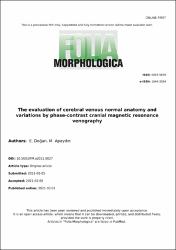The evaluation of cerebral venous normal anatomy and variations by phase-contrast cranial magnetic resonance venography
Citation
Doğan E, Apaydın M. The evaluation of cerebral venous normal anatomy and variations by phase-contrast cranial magnetic resonance venography. Folia Morphol (Warsz). 2021 Mar 22. doi: 10.5603/FM.a2021.0027. Epub ahead of print. PMID: 33749805.Abstract
Background: The aim of our study is to determine the ability of the PC-CMRV technique to detect cranial anatomy, variations, thrombosis, to reveal the deficits of the technique and to discuss the reasons for these deficits on a physics basis.
Materials and methods: PC's detection rates of anatomic variations and physiological filling defects (FDs) were evaluated in 136 patients and compared with the time-of-flight (TOF) technique MRI and cadaveric studies.
Results: The dominance correlation between the three evaluated sinuses (transverse sinus (TS), sigmoid sinus, jugular vein) which originated from different embryological buds were statistically significant and the right vessel chain was dominant. PC is inadequate to show some vessels like inferior sagittal sinus (anatomically, this vessel is approximately present in 100% of the cases, but it was only visualized in 41.2% of the patients in PC-MRI). Visualization of major veins was sufficient. PC-MRI creates physiological FDs in 27.2% (72,3% middle,10.3% inner,17% outer part) of the patients. The FDs were concentrated in the middle part and not observed in the dominant sinus.
Conclusions: The defects of visualization are present due to the PC's technique. It can be misdiagnosed as agenesis or thrombosis. PC creates a high incidence of physiologic FDs in TS. The results are not reliable, especially if FDs are in the middle part or non-dominant side.
Source
Folia MorphologicaURI
https://journals.viamedica.pl/folia_morphologica/article/view/72679https://hdl.handle.net/20.500.12809/9109


















